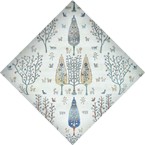Vist is a city in the Central District of Khansar County, Isfahan Province, Iran. Vist rugs originate from Vist, also referred to as Wist, a small town located near Khansar. However, for a small town, Vist has an eclectic mix of population. Nomadic people of Bakhtiari all call Vist home, and it is the influence from these diverse groups that is an integral part of the weaving of wool rugs here. Due to its largely nomadic population, the majority of Vist rugs feature geometric designs, which is an indication of a tribal rug.
All rugs have a wool pile colored with natural vegetable dyes. Very rarely is silk seen in this region. The foundation of the rug is usually cotton, and in some cases wool or goat hair. The patterns are usually simple geometric arrangements with vibrant primary colors. Sometimes small animals or garden elements are seen, and often the famous Herati design.
The single most defining characteristic of Vist rugs is a very unique center medallion, which is a rounded seven sided geometric shape that always has pair of jewel-like shapes at either end. In order to showcase this unusual design, Vist rugs most frequently have a red background and a large and intricate border. Other design elements in Viss rugs including the famous Herati motif, small animal figures, and a garden design are all variations of designs that are commonplace in the neighboring villages. The dominant colors used in Viss rugs are dark red, khaki, light blue, dark blue, and ivory. All of the dyes are created from the local vegetation.
The foundations on Vist rugs are cotton, although silk may be found on a very rare, old rug. The wool used to weave the pile is extremely thick and durable, giving these rugs the probability of lasting for centuries. The majority of Viss rugs are mid-size due to the compact looms. These boldly designed and dramatically shaded wool rugs will give any room in your home a look of polished elegance.

























Be the first to know about new designs and
exclusive offers, and get up to
10% OFF
your first purchase

Rugman.com since 1998 | The first and oldest online rug store
You can unsubscribe with a single click. We value your privacy; click here for more info.

You have one more step to join
Rugman Insider Club.
A coupon code will be emailed to you.
Please check your email and just
click the green “Confirm Subscription” button.

